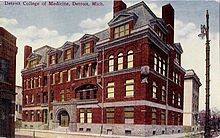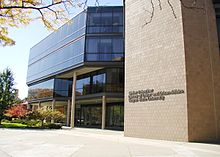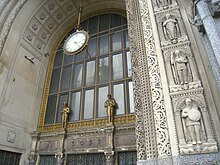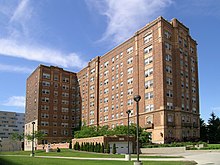
A | B | C | D | E | F | G | H | CH | I | J | K | L | M | N | O | P | Q | R | S | T | U | V | W | X | Y | Z | 0 | 1 | 2 | 3 | 4 | 5 | 6 | 7 | 8 | 9
This article contains academic boosterism which primarily serves to praise or promote the subject and may be a sign of a conflict of interest. (August 2023) |
 | |
Former names |
|
|---|---|
| Motto | "Industry, Intelligence, Integrity" |
| Type | Public research university |
| Established | 1868 |
| Accreditation | HLC |
Academic affiliations | |
| Endowment | $519.92 million (2021)[1] |
| President | Kimberly Andrews Espy |
| Provost | Laurie Lauzon Clabo |
Academic staff | 2,312[2] |
Administrative staff | 4,512[2] |
| Students | 24,931 (2021)[3] |
| Undergraduates | 16,851 (2021)[3] |
| Postgraduates | 8,080 (2021)[3] |
| Location | , , United States |
| Campus | Large city[4], 203 acres (0.82 km2) |
| Other campuses | |
| Newspaper | The South End |
| Colors | Green and gold[5] |
| Nickname | Warriors |
Sporting affiliations |
|
| Mascot | "W" the Warrior |
| Website | www |
 | |
Wayne State University (WSU or simply Wayne) is a public research university in Detroit, Michigan. It is Michigan's third-largest university. Founded in 1868, Wayne State consists of 13 schools and colleges offering approximately 350 programs to nearly 24,000 graduate and undergraduate students.[6] Wayne State University, along with the University of Michigan and Michigan State University, compose the University Research Corridor of Michigan.[7] Wayne State is classified among "R1: Doctoral Universities – Very high research activity".[8]
Wayne State's main campus comprises 203 acres linking more than 100 education and research buildings.[9] It also has three satellite campuses in Macomb and Wayne counties.
The Wayne State Warriors compete in the NCAA Division II Great Lakes Intercollegiate Athletic Conference (GLIAC).
History

The Wayne State University was established in 1868 as the Detroit Medical College by five returning Civil War veterans. The college charter from 1868 was signed by founder Theodore Andrews McGraw, M.D., a University of Michigan graduate (B.A. 1859).[10] In 1885, the Detroit College of Medicine merged with its competitor, the Michigan College of Medicine and they consolidated buildings. After the reorganization McGraw became the first president and dean holding these positions. These institutions evolved into Wayne State University School of Medicine.
In 1881, the Detroit Normal Training School for Teachers was established by the Detroit Board of Education. In 1920, after several relocations to larger quarters, the school became the Detroit Teachers College. The Board of Education voted in 1924 to make the college a part of the new College of the City of Detroit. This eventually became the Wayne State University College of Education.
In 1917, the Detroit Board of Education founded the Detroit Junior College and would make Detroit Central High School's Old Main Hall its campus. Detroit's College of Pharmacy and the Detroit Teachers College were added to the campus in 1924, and were organized into the College of the City of Detroit. The original junior college became the College of Liberal Arts. The first bachelor's degrees were awarded in 1925. The College of Liberal Arts of the College of the City of Detroit became the Wayne State University College of Liberal Arts and Sciences.

Recognizing the need for a good law school, a group of lawyers, including Allan Campbell, the school's founding dean, established Detroit City Law School in 1927 as part of the College of the City of Detroit. Originally structured as a part-time evening program, the school's first class graduated with the bachelor of laws degree (LL.B.) in 1928 and achieved full American Bar Association in 1939. The school became Wayne State University Law School.
In 1933, the Detroit Board of Education voted to unify its colleges into a university. In January 1934, that institution was officially named Wayne University, taking its name from Wayne County (in which both the university and the city of Detroit reside), which was itself named after Revolutionary War Major-General Anthony Wayne.[11]
Wayne University added a School of Social Work in 1935, and the School of Business Administration in 1946. Wayne University was renamed Wayne State University in 1956 and the institution became mandated by an amendment to the Michigan Constitution in 1959. The Wayne State University Board of Governors created the Institute of Gerontology in 1965 in response to a State of Michigan mandate. The institute's primary mission in that era was to engage in research, education and service in the field of aging. Wayne State University in 1973 added the College of Lifelong Learning. In 1985, the School of Fine and the Performing Arts, and the College of Urban, Labor, and Metropolitan Affairs further grew the university.
In the early 21st century, WSU constructed the Integrative Biosciences Center (IBio), a 207,000-square-foot (19,200 m2) facility for interdisciplinary work in the biosciences. More than 500 researchers, staff and principal investigators work out of the building, which opened in 2016.[12]

In 2013, M. Roy Wilson became Wayne State's 12th president. In 2018, the new Mike Ilitch School of Business facility opened in The District Detroit.[13]
In 2023, Kimberly Andrews Espy became Wayne State's 13th president.[14]
Presidents
Kimberly Andrews Espy is the university's 13th president, effective Aug. 1, 2023.
- 1933–1942 Frank Cody
- 1942–1945 Warren E. Bow
- 1945–1952 David D. Henry
- 1952–1965 Clarence B. Hilberry
- 1965–1971 William R. Keast
- 1971–1978 George E. Gullen Jr.
- 1978–1982 Thomas Bonner
- 1982–1997 David Adamany
- 1997–2008 Irvin D. Reid
- 2008–2011 Jay Noren
- 2011–2013 Allan Gilmour
- 2013–2023 M. Roy Wilson
- 2023–present Kimberly Andrews Espy
Governance
Under the Michigan Constitution, the members of the Wayne State University Board of Governors (as with the University of Michigan and Michigan State University) are elected by the citizens of Michigan statewide.
The university is governed by a Board of Governors consisting of eight members elected by Michigan voters for eight-year terms. Board of Governor members serve without compensation. The board elects a university president to serve as the chief executive officer of the university administration. The student body government is headed by a Student Senate (formerly the Student Council). Some colleges of the university have their own Student Senate, which reports back to the main Student Senate. The School of Law has its own Student Board of Governors.
Admissions
Undergraduate
| Undergraduate admissions statistics | |
|---|---|
| Admit rate | 62.7 ( |
| Yield rate | 28.4 ( |
| Test scores middle 50% | |
| SAT Total | 1010–1220 (among 60% of FTFs) |
| ACT Composite | 21–28 (among 8% of FTFs) |
The 2022 annual ranking of U.S. News & World Report categorizes Wayne State University as "selective".[16] For the Class of 2025 (enrolled fall 2021), Wayne State received 15,305 applications and accepted 9,603 (62.7%). Of those accepted, 2,732 enrolled, a yield rate (the percentage of accepted students who choose to attend the university) of 28.4%.[15] Wayne State's freshman retention rate is 81.3%, with 55.8% going on to graduate within six years.[15]
Of the 60% of the incoming freshman class who submitted SAT scores; the middle 50 percent Composite scores were 1010–1220.[15] Of the 8% of enrolled freshmen in 2021 who submitted ACT scores; the middle 50 percent Composite score was between 21 and 28.[15]
Together with Michigan State University, Michigan Technological University, Kalamazoo College, Hillsdale College, Calvin University, and Hope College, Wayne State is one of the seven college-sponsors of the National Merit Scholarship Program in the state. The university sponsored 9 Merit Scholarship awards in 2020. In the 2020–2021 academic year, 10 freshman students were National Merit Scholars.[17]
| 2021 | 2020 | 2019 | 2018 | 2017 | 2016 | |
|---|---|---|---|---|---|---|
| Applicants | 15,305 | 17,231 | 15,716 | 16,210 | 15,331 | 11,093 |
| Admits | 9,603 | 11,794 | 11,495 | 11,533 | 10,334 | 9,036 |
| Admit rate | 62.7 | 68.4 | 73.1 | 71.1 | 67.4 | 81.5 |
| Enrolled | 2,732 | 3,120 | 2,968 | 3,038 | 2,653 | 2,588 |
| Yield rate | 28.4 | 26.5 | 25.8 | 26.3 | 25.7 | 28.6 |
| ACT composite* (out of 36) |
21-28 (8%†) |
20-27 (19%†) |
21-27 (21%†) |
21-27 (24%†) |
21-28 (38%†) |
20-27 (97%†) |
| SAT composite* (out of 1600) |
1010-1220 (60%†) |
1000-1200 (91%†) |
1020-1230 (88%†) |
1010-1210 (89%†) |
1000-1210 (80%†) |
— |
| * middle 50% range † percentage of first-time freshmen who chose to submit | ||||||
Graduate
For fall 2022, Wayne State University Law School received 851 applications and accepted 302 (35.49%). Of those accepted, 125 enrolled, a yield rate of 41.39%. The law school had a middle-50% LSAT range of 154–163 for the 2022 first year class.[23]
Academics
Colleges and schools
Wayne State's academic offerings are divided among 13 schools and colleges: the Mike Ilitch School of Business; the College of Education; the College of Engineering; the College of Fine, Performing, and Communication Arts; the Graduate School; the Law School; the College of Liberal Arts and Sciences; the School of Information Sciences; the School of Medicine; the College of Nursing; the Eugene Applebaum College of Pharmacy and Health Sciences; the Irvin D. Reid Honors College; and the School of Social Work.[24] Fall 2021 enrollment for the university consisted of 24,931 students; freshman enrollment was 3,693 students.[25]
Wayne State offers approximately 350 undergraduate, post-graduate, specialist and certificate programs in 13 schools and colleges.[26] Its most popular undergraduate majors, by 2021 graduates, were:[27]
- Psychology (311)
- Public Health (262)
- International Business/Trade/Commerce (202)
- Biology/Biological Sciences (177)
- Registered Nursing/Registered Nurse (172)
- Marketing/Marketing Management (170)
- Organizational Behavior Studies (164)
- Computer and Information Sciences (160)
Mike Ilitch School of Business
The Mike Ilitch School of Business offers undergraduate degrees and graduate degrees, including the M.B.A. and M.S. as well as a Ph.D. The college also offers undergraduate and graduate certificates. These programs are accredited by the Association to Advance Collegiate Schools of Business.[28]
College of Education
The College of Education began as a teacher's college in 1881. The college offers bachelor's, master's, education specialist and doctoral degree programs in 37 program areas.
College of Engineering
Established in 1933, the College of Engineering offers a range of engineering disciplines.
College of Fine, Performing, and Communication Arts
Established in 1986, the College of Fine, Performing and Communication Arts (CFPCA) serves nearly 2,000 students majoring in 17 undergraduate programs, 12 graduate programs and four graduate certificate programs. Many programs are nationally accredited.[29]
Graduate school
Established in 1933, the Graduate School administers the application process for all graduate programs at Wayne State University with the exception of M.D., J.D. and PharmD programs. Additionally, the Graduate School oversees more than 2,000 Ph.D. students.
School of Information Sciences
The American Library Association first accredited the master of Library and Information Science (MLIS) degree in 1967. The MLIS degree is available online with select classes also offered on campus. In September 2017, the school became a member of the iSchool Consortium[30] and added a Master of Science in information management (MSIM) degree.
Irvin D. Reid Honors College
The Irvin D. Reid Honors College was founded in 2008. The college's undergraduate students are selected on the basis of academic performance. In addition to general education courses and courses in their majors, students in the Honors College enroll together in additional coursework which emphasizes academic skills and civic engagement.
Law School
Wayne Law blends legal theory with practice through seven legal clinics, five externship programs, local and international fellowships and internships, and co-curricular programs.
College of Liberal Arts and Sciences
The College of Liberal Arts and Sciences (CLAS) was formed in 2004 with the merger of the College of Liberal Arts and the College of Science. The college receives approximately $20 million a year in external grants and contracts. CLAS consists of 19 departments: Humanities, Social Sciences, Physical Sciences and Mathematics, and Life Sciences categories.
School of Medicine
Founded in 1868, the Wayne State University School of Medicine offers master's, Ph.D. and M.D./Ph.D. programs in 14 areas of basic science and public health to nearly 400 students annually. The school's research emphasizes neurosciences, pediatrics, obstetrics and gynecology, perinatology, cancer, cardiovascular disease including diabetes and obesity, and psychiatry and addiction research. One of the school's major assets is the Richard J. Mazurek, M.D., Medical Education Commons, which was designed specifically for students and houses classrooms, student services divisions, the medical library, a sophisticated patient simulation center and the Kado Family Clinical Skills Center.[31]
College of Nursing
Founded in 1945, the Wayne State University College of Nursing offers an education focused on both clinical practice and advancing the state of nursing research, with a focus on addressing health in urban communities. The college offers B.S.N., M.S.N., D.N.P., Ph.D. and graduate certificate programs. The Nursing Practice Corporation, the college's faculty practice plan, operates Wayne State's Campus Health Clinic, which provides health care services to the student community.
Eugene Applebaum College of Pharmacy and Health Sciences
Established in 1924, the Eugene Applebaum College of Pharmacy and Health Sciences is one of the founding colleges of Wayne State University. It is organized into four departments – fundamental and applied sciences, health care sciences, pharmacy practice and pharmaceutical sciences. It offers 11 fully accredited degree-granting programs, which maintain autonomous admission requirements, curricula, degree requirements and academic procedures.[citation needed]
School of Social Work
Established in 1935, the school offers academic programs at the bachelor's, master's and Ph.D. levels. The school's Center for Social Work Research provides support for faculty research and scholarship, engages in relevant research with community partners, and offers consultation and technical assistance. In fall 2019, the school had more than 900 students enrolled.
Research
Wayne State received $320 million in research awards in 2021.[32] Wayne State University, Michigan State University, and the University of Michigan are the three institutional members of the State of Michigan's University Research Corridor. The university's Division of Research includes several centers, institutes, and thematic initiatives,[33] including the Center for Molecular Medicine & Genetics, the Merrill Palmer Skillman Institute, the Institute of Gerontology, the Center for Urban Responses to Urban Stressors, Healthy Urban Waters, the Translational Neurosciences Initiative, and an initiative on Translational Sciences and Clinical Research Innovation.
Rankings
The university is ranked as tied for 250th in the 2022 U.S. News & World Report rankings of "National Universities" across the United States, and it is ranked tied for 124th nationally among public universities.[34]
| Academic rankings | |
|---|---|
| National | |
| ARWU[35] | 145–157 |
| Forbes[36] | 339 |
| U.S. News & World Report[37] | 250 |
| Washington Monthly[38] | 317 |
| WSJ/College Pulse[39] | 289 |
| Global | |
| ARWU[40] | 601–700 |
| QS[41] | 751–760 |
| THE[42] | 501–600 |
| U.S. News & World Report[43] | 385 |
Financialsedit
Wayne State University's cost of attendance is composed of tuition, including a credit hour rate, student service credit hour fee, fitness center maintenance fee, and a registration fee. Class maintenance fees are applied on a course-to-course basis. The tuition varies depending on undergraduate (lower and upper level division) and graduate students. Although graduate programs, Law School and Medical School tuition differs.
Campusedit


Wayne State's main campus in Detroit encompasses 203 acres (0.82 km2) of landscaped walkways and gathering spots linking over 100 education and research buildings.[44] The campus is urban and features many architecturally significant buildings, including the Helen L. DeRoy Auditorium, the Education Building, the Maccabees Building, Old Main, McGregor Memorial Conference Center, Chatsworth Tower Apartments, and the Hilberry Theatre. Many of these buildings were designed by notable architects such as Albert Kahn and Minoru Yamasaki.
Wayne State University is located in Midtown Detroit near notable institutions and attractions, including the Detroit Institute of Arts, the Detroit Historical Museum, the Michigan Science Center, the Charles H. Wright Museum of African American History, the Detroit Opera House/Michigan Opera Theatre, Detroit Symphony Orchestra/Orchestra Hall, Comerica Park, Ford Field, Little Caesars Arena, the Fox Theatre, the Fisher Theatre, Grand Circus Park and Campus Martius Park.
The Cass Corridor is one of the university's other notable surroundings, with a venerable history and culture that has left an imprint on many WSU alumni. Many notable events have taken place on or near the campus as a result of its unique location. Artists that got their start here include Chuck and Joni Mitchell, Alice Cooper, The White Stripes, The Detroit Cobras, MC5, The Stooges, Savage Grace, Ted Nugent, and Grand Funk Railroad. The Red Hot Chili Peppers recorded their Freaky Styley album in this area, which was also home to Creem magazine – the first rock journal, and the first to use the terms "punk rock" and "heavy metal" and give recognition to the likes of David Bowie, Iggy Pop, The Smiths and others. The now-razed Tartar Field was home to WABX's free Sunday concerts in the late 1960s and early 1970s featuring many of these musicians.
Librariesedit
With nearly four million volumes, the Wayne State University Library System houses the 75th largest collection in the United States, according to the American Library Association.[45]
- The Vera P. Shiffman Medical Library, located at Wayne State's medical campus, houses the university's medical and health collections and is the primary library for the School of Medicine and the Eugene Applebaum College of Pharmacy and Health Sciences.
- The Arthur Neef Law Library, located on the north section of the main campus adjacent to the Wayne State University Law School, houses the university's law collections and is the Law School's primary library. Its collection of over 620,000 volumes makes it the second largest law library in Michigan. The library subscribes to over 1,500 journals and 1,000 loose-leaf services.
- The Purdy/Kresge Library, located near the center of main campus, serves as the primary research library for the School of Information Sciences. It contains print and electronic resources to meet the research and instructional needs of faculty, graduate students, and upper-level undergraduates. It also houses the university's main government documents collection and the offices of the university's Media Services Department.[46]
- The David Adamany Undergraduate Library (UGL), located at the center of Gullen Mall, has numerous computer workstations providing students with access to electronic resources. Its book and magazine collection is intended to support the learning needs of 1000 and 2000-level undergraduate courses. The UGL houses the university libraries' collection of approximately videos, DVDs, laser discs and audiotapes. The UGL provides students with information on careers, computers and study skills. The UGL is open 24 hours for both students and faculty.[47]
- The Walter P. Reuther Library, Archives of Labor and Urban Affairs, located on the easternmost portion of main campus at 5401 Cass Avenue, is the largest labor archives in North America and serves as the official archival repository for twelve major unions. It was established as the Labor History Archives for Wayne States University in 1960. In addition to labor records, the archives contain primary source material related to civil and political rights, especially those related to Detroit. The Reuther also houses the Wayne State University Archives dating from the institution's founding as the Detroit Medical College in 1868.[48]
Housingedit

The university provides optional housing for all students in the form of apartments and residence halls. All buildings are equipped with connection to the university computer system, wireless Internet, laundry rooms, activity rooms, and a 24-hour help desk.[49] There are also many housing options within walking distance of the campus that are not affiliated with the university.
Current housingedit
Current university-owned apartment buildings consist of University Tower, Chatsworth Tower, and Anthony Wayne Drive Apartments. In the hopes of bringing more residents to campus, Wayne State opened two dormitory-style residence halls in 2002: Yousif B. Ghafari Hall (formerly North Hall) and Leon H. Atchison Hall (formerly South Hall). This was the first time since the closing of the Newberry Joy Dorms in 1987 that the university offered dorm living. In 2005, the university opened The Towers Residential Suites, a residence hall open to undergraduate and graduate students. The Towers Café, located in The Towers residential suites is the campus' largest dining facility, serving a variety of food. Gold 'n' Greens, located in Ghafari Hall, serves vegetarian, vegan, and kosher food.[50][51]
Tom Adams Fieldedit
Tom Adams Field, best known as Adams Field, is a 6,000-seat football stadium located on the campus. It is primarily used for Wayne State Warriors football of the Great Lakes Intercollegiate Athletic Conference, a Division II conference of the National Collegiate Athletic Association.
The Field was named after Thomas B. Adams, a 1944 graduate and football and track athlete who later served on as a board member at WSU. Due to his athletic, military, and business achievements the Wayne State Football field was named in honor of him on October 11, 2003.[52] The stadium turf has been replaced several times. The most recent replacement was in May 2015 when FieldTurfRevolution (2.5") artificial turf was installed.[53][54] A new 35-foot video board was installed in August 2015.[54] The eight lane Lowell Blanchard Track, located in the stadium, was first installed in 2006. Mondo surfacing was added to the track in 2011.[55]
Wayne State Fieldhouseedit
The Wayne State Fieldhouse, a 70,000-square-foot arena with seating for 3,000 fans, opened in October 2021. The arena is home to Wayne State's basketball teams as well as the Detroit Pistons' G-League team, the Motor City Cruise.[56]
Satellite campusesedit
Wayne State has three satellite campuses in the Metro Detroit area.[57] The locations are:
- University Center at Macomb Community College, Clinton Township
- Advanced Technology Education Center, Warren
- Schoolcraft College, Livonia
Student lifeedit
Student bodyedit
In fall 2021, Wayne State had a total of 24,931 students.[58]
